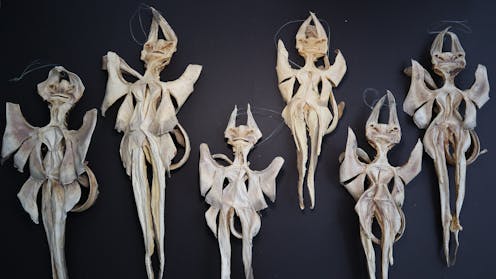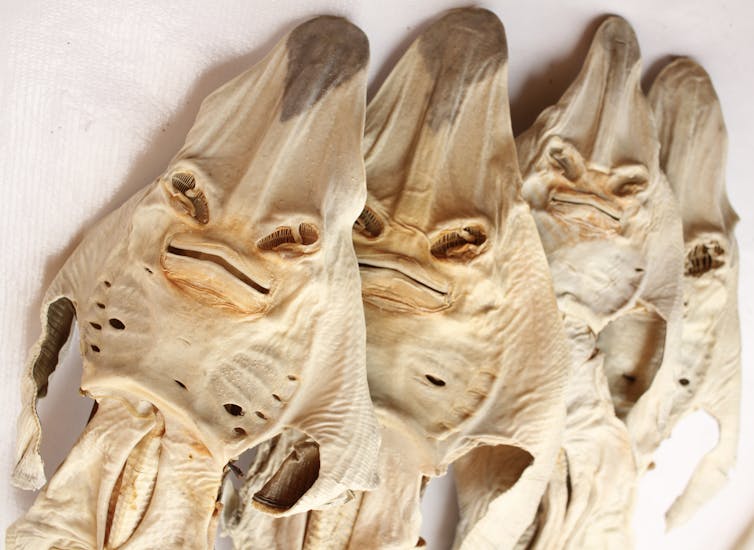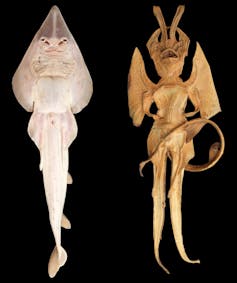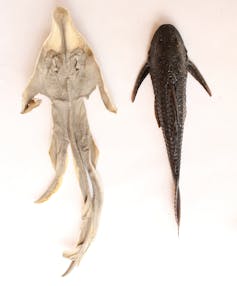Trade in a mythical fish is threatening real species of rays that are rare and at risk
- Written by James Marcus Drymon, Associate Extension Professor in Marine Fisheries Ecology, Mississippi State University
 These 'pez diablo,' or devil fish, are actually guitarfishes that have been caught, killed, dried and carved into exotic shapes. Bryan Huerta-Beltrán, CC BY-ND
These 'pez diablo,' or devil fish, are actually guitarfishes that have been caught, killed, dried and carved into exotic shapes. Bryan Huerta-Beltrán, CC BY-NDFrom the Loch Ness monster to Bigfoot, also known as Sasquatch, to the jackalope of the U.S. West, mythical animals have long captured human imagination.
Some people are so fascinated with mythical creatures that they create their own, either working from pure fantasy or by modifying real animals. In a newly published study, we show that in countries such as Mexico, people are catching, drying and shaping guitarfishes – members of the rhino ray family, one of the most threatened groups of marine fishes – to create mythical specimens called “pez diablo,” or devil fish.
Depending on where these curios are sold, they might also be referred to as Jenny Hanivers, garadiávolos or rayas chupacabras. The origin and meaning of the term “Jenny Haniver” is unclear, but the most accepted explanation is “Jeune d'Anvers,” or “young girl from Antwerp” in French.
We found that pez diablo are made for many reasons, including as curios for the tourist trade and as purported cures for cancer, arthritis and anemia. Some are simply used for hoaxes. Regardless, the pez diablo trade could threaten the survival of guitarfishes.
Young guitarfishes on display at the New England Aquarium in Boston.Fishy talismans
Skates and rays, including guitarfishes, are flat-bodied fishes related to sharks and are found worldwide. Together, they make up a group known as elasmobranchs, which are characterized by their unique skeletons made of cartilage rather than bone like most other fishes.
Skates have long been used to craft mythical creatures. The earliest known examples date back to 1558 in Europe, where they were fashioned to resemble dragons. These objects were thought to offer pathways to the divine or medicinal cures.
In the mid-20th century, dried guitarfishes emerged as a new generation of mythical creatures. This may be because their unique shape can be fashioned into more humanlike forms. Their long nostrils, which are positioned just above their mouths, can resemble eyes.
 The ‘eyes’ of these dried guitarfishes are actually nostrils on top of the fishes’ long, pointed snouts.Bryan Huerta-Beltrán, CC BY-ND
The ‘eyes’ of these dried guitarfishes are actually nostrils on top of the fishes’ long, pointed snouts.Bryan Huerta-Beltrán, CC BY-NDThe first known case of a modified guitarfish was described in 1933. Since then, specimens have made their way into museums, and dozens of North American newspapers have published stories featuring modified guitarfishes.
A real and endangered fish
Guitarfishes are one of the most threatened vertebrate groups on the planet: Without careful management, they are at risk of global extinction. As many as two-thirds of all guitarfishes are classified as threatened on the IUCN Red List, a global inventory that assesses extinction risks to wild species.
Guitarfishes are found in warm temperate and tropical oceans around the world. Fishers target them as an inexpensive source of protein. Guitarfishes may also be caught accidentally or collected live for the aquarium trade.
Ultimately, however, these species are worth more as pez diablo than for other uses. For example, an entire fresh guitarfish in Mexico is worth approximately US$2, whereas guitarfish that have been killed, dried and carved into pez diablo can be worth anywhere from $50–$500 on eBay and other e-commerce sites.
Curbing the pez diablo trade
Internationally, the guitarfish trade is regulated by the Convention on International Trade in Endangered Species of Wild Fauna and Flora, an international agreement between governments. This agreement requires member countries to manage guitarfish trade across international borders.
Most countries where guitarfishes occur, however, do not have national regulations to protect these species. As a result, people who create or sell pez diablo are likely unaware that these fishes are threatened.
There are as many as 37 species of guitarfish, some of which are at higher risk of extinction than others. Yet to the untrained eye, it can be hard to distinguish one guitarfish species from another. It’s especially hard to identify dried and mutilated guitarfishes that have been processed into pez diablo and look very different from their natural form.
 An intact guitarfish, left, and a carved, dried version.Bryan Huerta-Beltrán, CC BY-ND
An intact guitarfish, left, and a carved, dried version.Bryan Huerta-Beltrán, CC BY-NDThis is a common challenge for agencies that monitor trade in animal products. The global wildlife trade is an enormous market, involving billions of animals moving through both legal and illegal channels. Many wildlife products are heavily altered, which makes it hard to identify the species and determine where the product came from.
Another source of confusion is that many people in Mexico also refer to an invasive freshwater fish that has overrun lakes and rivers across the nation as pez diablo. This “other” pez diablo is actually a suckermouth catfish and is not at all related to any of the threatened guitarfishes. Local education efforts need to distinguish clearly between these two species, since the desired outcome is to protect guitarfish while removing the invasive catfish.
 A dried and modified guitarfish, left, compared with an invasive suckermouth catfish.Bryan Huerta-Beltrán, CC BY-ND
A dried and modified guitarfish, left, compared with an invasive suckermouth catfish.Bryan Huerta-Beltrán, CC BY-NDGuitarfish CSI
Fortunately, advances in wildlife forensics offer a way to distinguish between species. Molecular techniques have been used to identify many illegally traded species, including guitarfishes. By taking a small skin sample, scientists can use DNA to identify the species of individual pez diablo. This method can help protect endangered species by helping to ensure that laws against wildlife trafficking are followed.
Refining this kind of molecular tool is the most promising way to improve traceability in the trade of guitarfishes. By documenting where and how pez diablo are traded, scientists and conservationists can help clarify the threats to these species. The pez diablo is an imaginary creature, but it is doing real harm to threatened guitarfishes in the world’s warm oceans.
Bryan Huerta-Beltran receives funding from Save Our Seas Foundation.
Nicole Phillips is affiliated with the Sawfish Conservation Society and receives funding from the Save Our Seas Foundation.
James Marcus Drymon and Peter Kyne do not work for, consult, own shares in or receive funding from any company or organization that would benefit from this article, and have disclosed no relevant affiliations beyond their academic appointment.
Authors: James Marcus Drymon, Associate Extension Professor in Marine Fisheries Ecology, Mississippi State University

